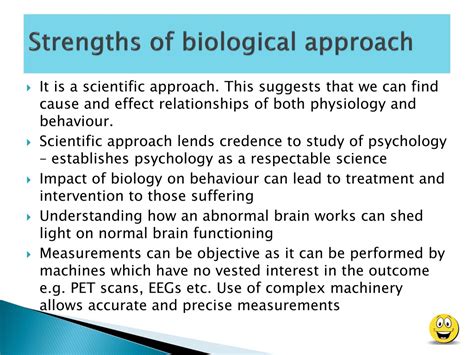Strengths Of The Biological Approach

The biological approach to psychology is a vital component of the field, focusing on the role of biological processes in shaping behavior and cognitive functions. This approach has several strengths, making it a crucial aspect of understanding human behavior and mental processes. One of the primary strengths of the biological approach is its ability to provide a clear and direct link between biological processes and behavior. By examining the structure and function of the brain, nervous system, and other bodily systems, researchers can identify specific biological mechanisms that underlie various behaviors and mental processes.
Reductionism and Testability

The biological approach is often characterized by its reductionist nature, which involves breaking down complex phenomena into their constituent parts to understand how they work. This approach allows for a more detailed and nuanced understanding of biological processes and their relationship to behavior. Furthermore, the biological approach is highly testable, as hypotheses can be formulated and tested using empirical methods, such as neuroimaging techniques, neurophysiological recordings, and pharmacological interventions. This testability enables researchers to refine their theories and models, making the biological approach a rigorous and systematic framework for understanding behavior.
Empirical Evidence and Neuroplasticity
A significant strength of the biological approach is the wealth of empirical evidence supporting its theories and models. Advances in neuroimaging techniques, such as functional magnetic resonance imaging (fMRI) and electroencephalography (EEG), have enabled researchers to non-invasively examine brain structure and function in vivo. These techniques have provided valuable insights into the neural mechanisms underlying various behaviors, including perception, attention, memory, and emotion regulation. Additionally, the discovery of neuroplasticity, which refers to the brain’s ability to reorganize and adapt throughout life, has highlighted the dynamic and malleable nature of brain function, underscoring the importance of considering biological processes in understanding behavior.
| Biological Process | Behavioral Correlate |
|---|---|
| Neurotransmitter release | Mood regulation |
| Neural oscillations | Attention and perception |
| Hormonal fluctuations | Emotion and motivation |

In addition to its theoretical and empirical strengths, the biological approach has numerous practical applications. For instance, the development of pharmacological interventions, such as antidepressant medications, has been informed by our understanding of the biological mechanisms underlying mood disorders. Similarly, the use of neurostimulation techniques, such as transcranial magnetic stimulation (TMS) and transcranial direct current stimulation (tDCS), has shown promise in the treatment of various neurological and psychiatric conditions.
Clinical Applications and Limitations

While the biological approach has numerous strengths, it is not without its limitations. One of the primary criticisms of the biological approach is its potential to overlook the role of environmental and social factors in shaping behavior. Additionally, the biological approach can be reductionist, focusing on the biological mechanisms underlying behavior at the expense of considering the complex interactions between biological, psychological, and social factors. Nevertheless, the biological approach remains a vital component of psychology, providing a unique perspective on the biological mechanisms underlying behavior and informing the development of novel treatments and interventions.
Future Directions and Integration
Future research in the biological approach is likely to focus on the integration of biological, psychological, and social factors in understanding behavior. The development of novel neuroimaging techniques, such as diffusion tensor imaging (DTI) and magnetoencephalography (MEG), will enable researchers to examine brain structure and function in greater detail, providing new insights into the neural mechanisms underlying behavior. Furthermore, the increasing recognition of the importance of neuroplasticity and the dynamic nature of brain function will underscore the need for a more nuanced understanding of the interplay between biological, psychological, and social factors in shaping behavior.
What is the primary focus of the biological approach to psychology?
+The primary focus of the biological approach to psychology is the role of biological processes in shaping behavior and cognitive functions.
What are some of the strengths of the biological approach?
+Some of the strengths of the biological approach include its ability to provide a clear and direct link between biological processes and behavior, its reductionist nature, and its testability using empirical methods.
What are some of the limitations of the biological approach?
+Some of the limitations of the biological approach include its potential to overlook the role of environmental and social factors in shaping behavior and its reductionist focus on biological mechanisms at the expense of considering complex interactions between biological, psychological, and social factors.
